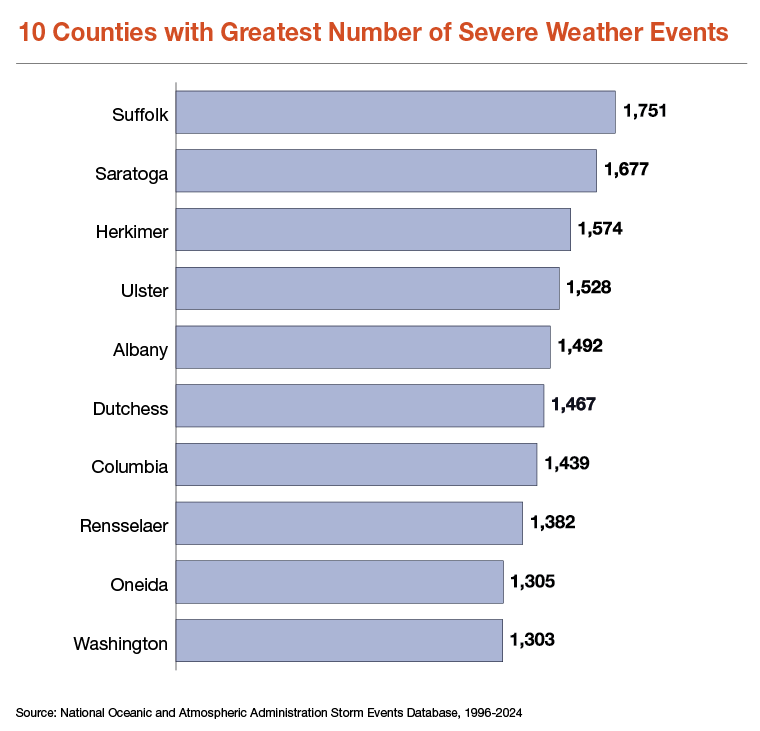A new report from State Comptroller Thomas P. DiNapoli found the frequency of severe weather in the state is growing, taking a toll on New York’s residents, property and economy. While New York is investing to reduce those impacts through the Clean Water, Clean Air and Green Jobs Bond Act, DiNapoli warned that the federal government should expand its funding and efforts, not claw back funds and leave states and communities vulnerable to extreme weather and flooding.
Since 1998, federal assistance to New York provided for declared disasters and emergencies has averaged $958.6 million in aid annually. While actual annual amounts are variable based on the severity of weather events, the aid provided captures only a portion of the full cost of the damages.
“Extreme weather events are happening more and more often and inflicting financial and emotional stress on New Yorkers from loss of life to property destruction,” DiNapoli said. “From flooded subway tunnels and roadways to destroyed and damaged homes, the consequences are dire and growing. Fortunately, New Yorkers approved the Clean Water, Clean Air and Green Jobs Environmental Bond Act, which will help pay for resilience investments, but the state cannot shoulder the whole cost burden itself. The federal government cannot abandon the states in preparing for and responding to disasters.”
DiNapoli’s report utilized data produced by the National Oceanic and Atmospheric Administration (NOAA), the Federal Emergency Management Agency (FEMA), and the National Flood Insurance Program (NFIP), as well as analysis in the New York State Hazard Mitigation Plan. Major findings include:
- Weather-related disasters that cause $1 billion or more in damage have occurred at an increasing rate since 1980.
- Severe weather events are increasing in New York and certain types of events, including thunderstorm-related damaging wind and flash flooding, are also increasing.
- Since 1998 there have been an average of 2.5 weather events per year in New York that resulted in federal disaster or emergency declarations with authorized annual assistance averaging $958.6 million.
- There have been 594 deaths in the state due to severe weather between 1996 and 2024. Heat and extreme heat events caused the most deaths (122), followed by rip currents (62), and flash flooding (57).
New York State has dedicated $1.1 billion of the $4 billion bond act to projects to move structures and infrastructure out of high flood risk zones, restore natural drainage features like flood plains and wetlands that can help control storm water and projects to protect infrastructure from floods. Through August 2025, $129.7 million in restoration and flood risk reduction projects have been awarded.(Report Appendix includes bond act grant awards in specific communities). Other corporate and municipal entities are also undertaking such resiliency investments, which are essential for the protection of lives and infrastructure and future economic growth.
Severe Weather Events
The NOAA Storm Events Database reports incidents of powerful weather in “episodes” and “events.” Episodes are weather patterns that generally affect a region of the state, while events are recorded as the results of these weather patterns in a county or a portion of a county. From 1996 through 2024, events have increased over time, with three out of the four years with the highest numbers of severe weather events occurring in 2019 (2,498), 2021 (2,395) and 2024 (2,268). Among types of events, winds associated with thunderstorms were the most common type of severe weather, with 14,824 incidents recorded, followed by hail (4,315), flash floods (3,985), winter weather (3,817) and winter storms (3,714). These five types accounted for 63.1% of all events.
Since 1996, there have been more flash floods occurring in New York. The largest numbers occurred in recent years, with the first, second and sixth largest numbers of flash floods occurring in the last four years. Thunderstorm wind events also increased significantly over the period, with the top seven years with the largest number of such events taking place in the last eight years. Suffolk County experienced the highest number of severe weather events during the period reviewed, followed by Saratoga, Herkimer, Ulster, Albany, Dutchess, Columbia, Rensselaer, Oneida and Washington Counties.
Economic and Human Impacts
Nationwide, NOAA has found that weather related disasters that cause $1 billion or more in damage increased since 1980. In the 1980s there were 82 days between one of these highly damaging events on average, whereas between 2020 and 2024 there was only an average of 16 days. Damage figures from NOAA show the most property damage is attributed in New York to flash flooding ($2.5 billion), flooding ($1.2 billion), thunderstorm wind ($294 million), and high wind ($228 million).
Controlled for inflation, data on claims paid by NFIP in New York shows an increasing trend in the amount of money paid to remediate flood damaged buildings. The highest payments were related to Superstorm Sandy in 2012, which amounted to $5.8 billion, adjusted for inflation. In nominal terms, from 1978 to 2024, Nassau and Suffolk counties received the majority of the payments at 59.2%.
State Support for Climate Resilience
The bond act passed by state voters in 2022 allocates funding that can help municipalities upgrade infrastructure to address severe weather impacts of climate change, or move buildings and infrastructure out of high-risk flood zones. The bond act includes $1.1 billion for restoration and flood risk reduction projects. In addition, state programs such as Climate Smart Communities (CSC) or the Smart Growth Countywide Resiliency Program (SGCRP) assist municipalities in identifying the hazards they face from climate change and in developing climate adaptation plans to address these hazards. Municipalities that participate in the CSC or SGCRP may be eligible for grants made available through the Environmental Protection Fund or the bond act.
The state is currently in the process of developing a comprehensive statewide adaptation and resilience plan. The plan is intended to “establish a coordinated strategy to increase resilience, build adaptive capacity across New York communities, and develop tools and resources to help communities thrive in a changing climate.
Recommendations
According to the U.S. Chamber of Commerce, climate resilience expenditures reduce the cost of cleanup and rebuilding by as much as $6 for every dollar spent and lower economic damage by as much as $7 for every dollar spent. DiNapoli’s report recommends the State Adaptation and Resilience Plan include a clear assessment of associated costs, revenue sources and a timeline for implementation.
The state should also partner with local communities on projects and redouble its efforts to assist municipalities in planning and developing cost-effective initiatives to mitigate extreme weather and to facilitate communities’ ability to access resilience funding in the bond act. It should also provide oversight so projects are completed in a timely and affordable way. Given the increase in severe rain events, capacity for storm water management may need to be upgraded in New York’s urban areas. Serious consideration should be given to planning for protecting lives and property in areas at high risk for flooding and limit development in these areas. Attention should also be paid to disadvantaged communities located in areas that may be at greater risk, such as those in flood plains.
Report
Severe Weather Events and Resiliency in New York State
Related Work
New York’s Local Governments Adapting to Climate Change: Challenges, Solutions and Costs
Metropolitan Transportation Authority – MTA Bridges & Tunnels, MTA Bus Company, and New York City Transit-Department of Buses: Risk Assessment and Implementation of Measures to Address Extreme Weather Conditions
Metropolitan Transportation Authority – Long Island Rail Road: Mitigation for Extreme Weather Conditions and Flooding

